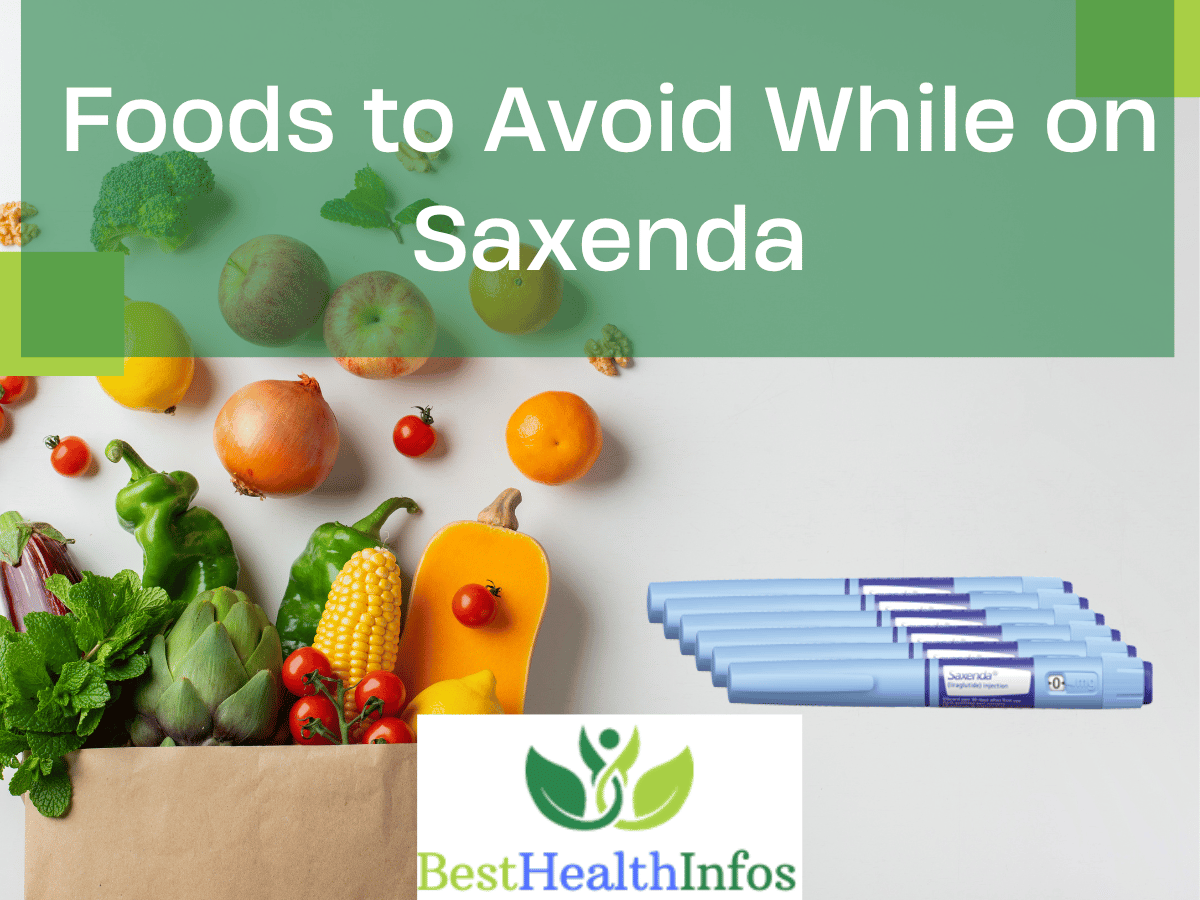While Saxenda can be a powerful tool in your weight loss journey, it’s important to remember that it works best when combined with a healthy diet and regular exercise. You should avoid certain foods while taking Saxenda to maximize its effectiveness.
Also Read: Gestational Diabetes Self-Care
These foods not only hinder your weight loss progress but may also cause adverse reactions when combined with the medication. So, before you reach for that tempting treat, read on to find out which foods to avoid while on Saxenda.
What is Saxenda?
Saxenda, in simple terms, is a brand-name prescription medication. Known scientifically as Liraglutide, it’s a weight-management aid garnering worldwide attention. Originating from Denmark, Novo Nordisk is the pharmaceutical mastermind behind Saxenda. This medication is uniquely designed to help individuals who struggle with obesity or weight-related medical conditions.
This injectable drug works alongside a reduced-calorie diet and increased physical activity to promote weight loss. So, what makes Saxenda stand out? It’s an analog of a human hormone called GLP-1, tricking the brain into thinking the stomach is full, thus reducing hunger and calorie intake.
What does Saxenda do?
Saxenda, a revolutionary weight-loss medication, works wonders in managing weight. Acting as an appetite suppressant, it tricks your brain into feeling full, decreasing overall food consumption. The unique GLP-1 analog imitates a natural hormone in your body, sending “I’m full” signals to your brain, even when you’ve eaten less than usual.
This results in a lower calorie intake and supports weight loss efforts. Remember, Saxenda isn’t a magic bullet – it’s most effective when combined with a healthy diet and regular exercise. It’s like a supportive friend, working with your lifestyle changes to help you achieve your weight-loss goals. It’s the nudge in the right direction many need in their weight-loss journey.
Also Read: What are Sperm Cramps?
How does Saxenda work?
Just like a strategic game of chess, Saxenda uses a calculated approach to help manage weight. Here’s how:
It mimics the GLP-1 hormone:
Saxenda mirrors a naturally occurring hormone in our bodies, glucagon-like peptide-1 (GLP-1). This hormone typically helps regulate our appetite.
Sends ‘Fullness’ signals:
Saxenda plays an incredible trick on our brain once in the bloodstream. It simulates the same ‘full’ feeling that GLP-1 induces after eating.
Reduces hunger and appetite:
As a result, you feel less hungry. It curbs your appetite significantly, thereby lowering your overall caloric intake.
Boosts weight loss efforts:
With reduced hunger and fewer calories consumed, Saxenda complements your diet and exercise efforts for effective weight loss.
Saxenda doesn’t just stop at making you feel full and embarks on a mission to reduce calorie intake and promote weight loss. It’s a weight-loss partner you didn’t know you needed.
What to eat when taking Saxenda
Saxenda works best when complemented with a healthy diet. Here’s a handy guide to help you choose what to eat:
Opt for lean proteins:
Foods like chicken, turkey, and fish are excellent choices. They not only keep you full but also help maintain muscle mass.
Prioritize fiber-rich foods:
Incorporate beans, lentils, oats, and whole grains into your meals. They prolong the feeling of fullness and stabilize blood sugar levels.
Load up on vegetables:
Vegetables are low in calories but high in fiber and nutrients. They fill your plate without adding excess calories.
Select healthy fats:
Avocados, nuts, and seeds provide essential fatty acids that keep you satiated.
Drink ample water:
Staying hydrated can help control hunger pangs.
Remember, Saxenda’s function is to reduce your appetite, so filling up on nutrient-dense, filling foods will optimize its effectiveness.
What foods to avoid when taking Saxenda
While taking Saxenda, it’s essential to steer clear of specific foods for optimal effectiveness:
High-Sugar Foods:
These include candies, cookies, soda, and pastries. Such foods can spike blood sugar levels and counteract Saxenda’s appetite-suppressing effect.
Fast Foods:
These are typically high in trans fats and sodium, which can contribute to weight gain and disrupt Saxenda’s benefits.
Refined Carbohydrates:
Foods like white bread and pasta provide less satiety, possibly leading to overeating.
Processed Meats:
Sausages and deli meats often contain high amounts of sodium and unhealthy fats.
Alcoholic Beverages:
Alcohol is calorie-rich and can increase your appetite, hindering your weight loss efforts.
Remember, the goal is to decrease caloric intake and maximize Saxenda’s weight loss benefits. So, choosing nutrient-dense over calorie-dense foods is crucial.
Also Read: Roemheld Syndrome: Hidden Health Issues
Is there a food plan to go with Saxenda?
Absolutely! While no one-size-fits-all diet plan exists, a balanced, nutritious meal plan can enhance Saxenda’s effectiveness. Think protein-rich breakfasts, hearty vegetable-based lunches, and lean meat dinners. Remember to sprinkle in some healthy fats, like avocado and nuts. Pair these with high-fiber snacks like fresh fruits and whole-grain crackers to keep you satiated.
Also, remember to stay hydrated! Sipping on water throughout the day can help control hunger pangs. A registered dietitian can provide personalized guidance, considering your unique dietary needs and preferences. Remember, this isn’t about deprivation but making healthier choices that align with your weight loss goals while on Saxenda.
Can you take Saxenda on an empty stomach?
Saxenda can be taken on an empty stomach. However, it’s essential to consider your tolerance. Some individuals may experience nausea when taking medications without food. Consider having a light snack before your dose if you’re one of them. Foods like whole grain toast or a piece of fruit can help.
Remember, Saxenda is designed to reduce your appetite, so overeating isn’t necessary. Taking it with or without food is a personal preference, but always heed your body’s responses. Adjust your meal timing and size based on your comfort and Saxenda’s effectiveness. Navigating your weight loss journey can be a unique experience, so make decisions that suit you best.
Will Saxenda make me feel nauseous?
Nausea can sometimes be a sidekick when you start your journey with Saxenda. This side effect is generally mild and temporary, fading away as your body adjusts to the medication. However, only some experience it. If you do, don’t fret! There are strategies to cope with it. For starters, injecting Saxenda with a meal can often reduce nausea.
Also, remember to hydrate, as dehydration can amplify this feeling. Don’t rush to increase your dosage – allow your body time to acclimate to the current dose. If nausea persists or becomes severe, it’s always best to contact your healthcare provider. Remember, Saxenda is a part of your weight-loss journey, and dealing with minor bumps is normal.
What Side Effects Should I Avoid With Saxenda?
While Saxenda is beneficial for weight loss, it may have some side effects. Here are some to watch out for:
Nausea:
This is often temporary and can be reduced by taking Saxenda with meals. Hydration is vital, too!
Diarrhea or constipation:
Monitor your body’s responses and adjust your diet accordingly. Fiber-rich foods can help regulate bowel movements.
Dizziness or fatigue:
If these symptoms persist, it’s essential to consult your healthcare provider.
Injection site reactions:
Redness, itching, or swelling may occur at the injection site. If these worsen, get medical help immediately.
Mood changes:
Unusual mood swings, depression, or thoughts of suicide are serious side effects that need immediate medical attention.
Remember, everybody is unique and may react differently to Saxenda. Always seek professional medical advice if you experience any discomfort.
Also Read: Best Time To Take Horny Goat Weed
Understanding the Basics of Saxenda
Diving into the basics of Saxenda, let’s untangle the ropes:
- Saxenda is an injectable prescription medication. Originating from Denmark, it’s become a notable tool in the weight-loss industry.
- The magic ingredient? Liraglutide, a GLP-1 analog. Think of it as a copycat hormone, mimicking your body’s natural appetite regulation.
- So, how does it work? Saxenda signals your brain that you’re full, even when you’ve eaten less than usual.
- It’s not a standalone solution but a supportive ally. Saxenda works best in combination with a balanced diet and consistent exercise.
- And the result? Reduced calorie intake, controlled hunger, and consequently, effective weight management.
Remember, Saxenda is not just a medication; it’s a tool to enhance your health and well-being.
High Fat and Calorie-Rich Foods to Avoid
Unleashing the full power of Saxenda means dodging inevitable dietary landmines. Start by side-stepping high-fat foods. Picture creamy sauces, fried snacks, and fatty cuts of meat. These calorie-packed culprits can sabotage Saxenda’s effectiveness. Next on the blocklist are calorie-rich foods. Think sugary cereals, granola bars, and pastries.
Consuming these foods can lead to overeating, undermining Saxenda’s hunger-curbing magic. Similarly, fast food and pre-packaged meals should be avoided. These food items are notorious for their high sodium and fat content, often hiding an alarming amount of calories. Remember, your goal is to promote Saxenda’s performance, not hinder it.
Best foods to eat on Saxenda
To enhance saxenda’s effectiveness, load up on these nourishing foods:
Wholesome Proteins: Grilled chicken, baked fish, and tofu should take center stage in your meals.
Fiber-Stars:
Integrate lentils, beans, and oats into your diet. These fiber-dense foods keep you full longer.
Nutrient-rich vegetables:
Colorful veggies are your allies. Think leafy greens, bell peppers, and broccoli. They’re packed with nutrients without the calorie hit.
Hydration Heroes:
Opt for herbal teas and fresh, homemade smoothies besides water. They keep you hydrated while adding a flavor burst.
Remember, a well-balanced, nutrient-rich diet is the secret weapon to optimize Saxenda’s power in your weight-loss journey. It’s all about smart food choices. Be creative, enjoy your meals, and watch Saxenda work magic.
For example, Saxenda’s diet plan
Ready to take your Saxenda weight loss journey to the next level? Here’s a sample diet plan to inspire you:
Breakfast:
Begin your day with a protein-rich meal. Try a spinach and mushroom omelet with a slice of whole-grain toast.
Mid-morning Snack:
Satisfy your hunger pangs with a fiber-filled snack. A small apple with a handful of almonds is a great choice.
Lunch:
Opt for a hearty salad with colorful veggies, grilled chicken, and a drizzle of olive oil.
Afternoon Snack:
Opt for a refreshing Greek yogurt topped with fresh berries and a sprinkle of chia seeds.
Dinner:
End the day with a balanced meal. A piece of grilled salmon, a side of roasted sweet potatoes, and steamed broccoli fits the bill.
Hydrate:
Remember to sip on water and herbal teas throughout the day.
Remember, this is just a guide. Feel free to tweak it according to your preferences. Eating well doesn’t mean eating less; it’s about making mindful, nutritious choices.
Frequently Asked Question
1. Can you eat normally on Saxenda?
Saxenda is designed to reduce your appetite, but you must maintain a balanced, nutritious diet. While you may eat less, the focus should be on eating healthy.
2. Can I eat rice on Saxenda?
Yes, but opt for whole-grain rice as it’s more filling and nutritious than white rice. Remember, portion control is critical.
3. What should you not take with Saxenda?
Avoid high-sugar foods, processed meats, fast foods, refined carbohydrates, and alcoholic beverages. These can hinder the effectiveness of Saxenda.
4. How do I maximize my Saxenda results?
Combine Saxenda with a balanced diet and regular exercise. Opt for lean proteins, fiber-rich foods, vegetables, and healthy fats. Stay hydrated and avoid high-sugar, fast, and processed foods.
5. How much weight can you lose on Saxenda in 2 weeks?
Weight loss varies depending on your diet and physical activity. Some people report losing 2-3 pounds weekly, but individual results may vary.
6. Does Saxenda work without dieting?
Saxenda is designed to support a reduced-calorie diet and increased physical activity. It may only be as effective with these lifestyle changes.
Conclusion
Saxenda is more than just a weight-loss medication. It’s a supportive ally in your journey towards improved health and well-being. Complementing it with a balanced diet and regular exercise is critical to maximizing its benefits. Remember, it’s not about restricting but choosing nourishing, nutrient-dense foods that support weight loss.
Steering clear of high-sugar, processed, and fast foods further enhances Saxenda’s effectiveness. Listen to your body, note how it responds, and adjust accordingly. Reach out to healthcare professionals when needed. After all, every weight-loss journey is unique. Yours is no different. Embrace it with Saxenda, and pave the way for a healthier, happier you. Keep going! You’ve got this!
Reference:



